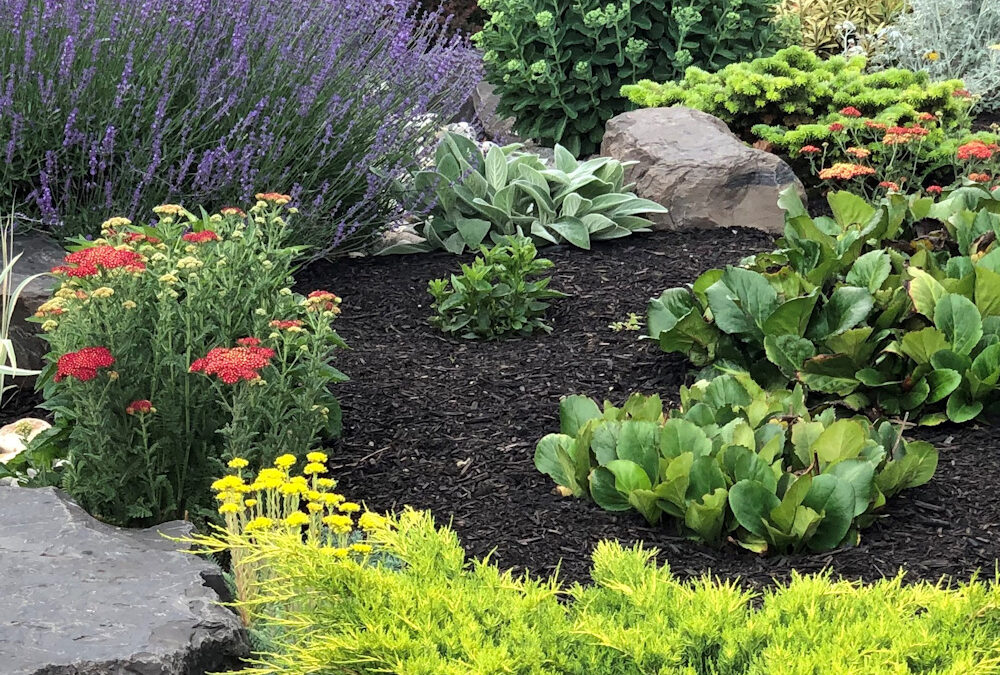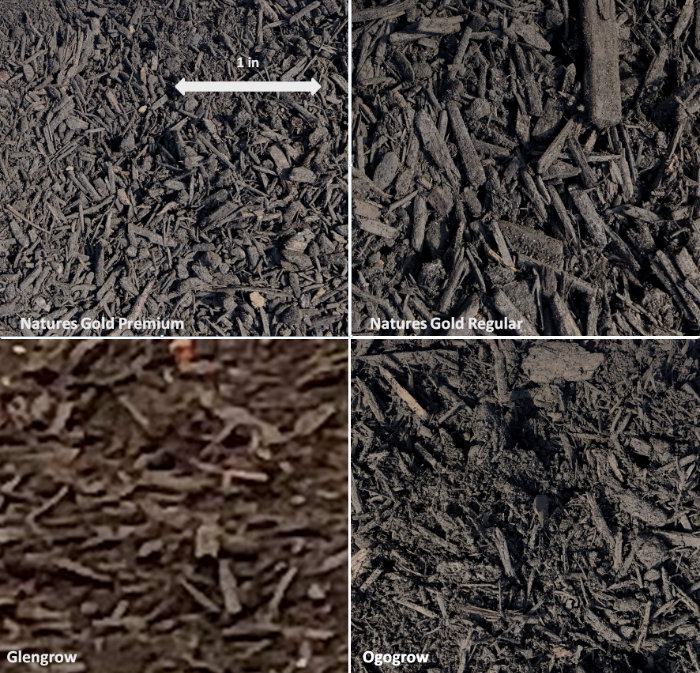Article and Photos by Mark Godlewski–
This is the first part of a two-part blog entry. This first entry will cover the types of mulch commonly available in our area and their relative advantages and disadvantages. The second entry will cover a set of flammability tests that OXA carried out on mulches in the last couple of years.
True xeriscape gardening generally requires the use of mulch.
Available mulches vary significantly depending on where you live, however they can be divided into four general categories:
• Recycled Synthetic Mulches (plastic, rubber, etc.)
• Rock Mulches
• Wood Waste Mulches (bark, needles, wood chips)
• Composted Mulches
We are not aware of any Recycled Synthetic Mulches being used in the Okanagan. This is a good thing because they would not fit into our “Gardening with Nature” mantra, and they are most often quite flammable.
Rock Mulches are widely used in the Okanagan. OXA does not generally recommend rock mulches. They have some advantages, but their disadvantages usually dissuade keen gardeners.
Rock Mulch advantages
• Conserves water
• Nonflammable
• Inhibits weed germination
• Comes in a wide variety of colours and textures
• Long lasting (more expensive to begin with but less expensive in the long run)
• Withstands movement by wind and rain
• Large leaves easy to remove with blower
• Withstands foot traffic well
Rock Mulch disadvantages
• Increase the soil temperature in the summer. Dark coloured rocks increase the temperature the most but light coloured rocks can also reflect light into the foliage increasing the chance of desiccation.
• May increase soil alkalinity
• In the winter, the rocks conduct the cold into the ground quite effectively.
• Tend to be more expensive to purchase and install
• Usually requires landscape cloth underneath which creates a barrier to natural aeration and transpiration of the soil
• Does not break down to feed the soil
• Although weeds are less likely to germinate in rocks, they are more difficult to remove once they mature.
• Over time the space between the rocks will fill up with dirt and debris, seeds will germinate more easily, and the weeds will be even more difficult to remove. The dirt/rock mix looks unattractive and is exceedingly difficult to separate.
Wood Waste Mulches are used fairly commonly in the Okanagan. We are surrounded by productive pine forests and there are several sawmills located in our valley. Wood waste mulches include bark, wood chips, and pine needles.
Wood Waste (bark) advantages
• Conserves water
• Natural parts of the local environment
• Easy to install
• Inhibits weed germination
• Comes in a wide variety of colours and textures
• Relatively long Lasting
• Withstands foot traffic
• Insulates the ground
Wood Waste (bark) disadvantages
• Flammable (a major issue in our part of the world)
• Bigger pieces can tend to work into the soil making digging difficult
• Does not contribute much to the soil
Fig. 1 – Examples of Composted Mulches available in the Okanagan
Composted Mulches are widely used in the Okanagan and are our preferred mulching solution. The common types are Glengrow, Ogogrow and Natures Gold. All are composted at high temperatures. Glengrow uses only landscaping waste from the recycling bins etc. whereas Ogogrow uses wood waste together with carefully treated biosolids from the sewage system. Natures Gold takes Ogogrow and separates it into a premium and regular mulch based on particle size. All of these composted mulches start out as a dark charcoal colour that slowly fades to grey.
Composted Mulch advantages
• Conserves water
• Generally non-flammable
• Natural parts of the local environment
• Easy to install
• Inhibits weed germination
• Works its way into the soil feeding it
• Looks like dark rich organic soil
• Insulates the ground
Composted Mulch disadvantages
• Needs to be replenished every 2-5 years
• Can be dislodged by wind, rain or foot traffic
The choice of mulch interplays with your choice of plants. Some plants such as yucca, ice plant and other succulents look very natural next to rocks and they can handle the heat. Also, it is a good idea that the plant foliage contrasts nicely with the mulch especially if you are using a sparse planting plan. For example, blue chip juniper will look a lot better on dark organic mulch compared to Kettle Granite.
We should remind our readers that there is yet another choice for mulch – living mulch. Living mulches are low plants that spread to cover the ground and suppress weeds. This is the subject of an earlier blog entry.



Great summary, Mark! I use Nature’s Gold and Ogogrow as a mulch in my own garden and it makes the plantings really pop. I was lucky enough to tour the Regional Compost Facility in 2017 and see how the biosolids are processed. It was late November (so quite cold out) and I couldn’t believe the heat coming off of it!
Interesting that you mention the heat coming off the biosolid waste. I have been told that you need to be careful, in summer, to spray the mulch with water soon after is laid down otherwise you risk burning the lower leaves on plants just like with fertilizer.
I would like to see an article on how to mulch in a firesmart way that is also good for the plants. I currently use Nature’s gold regular mulch but I am told it is not firesmart?
There is a blog entry on this subject https://okanaganxeriscape.org/mulch-flammability/ and it states that composted mulches like Nature’s Gold are in fact firesmart.